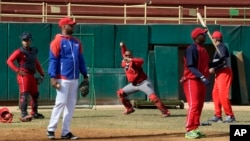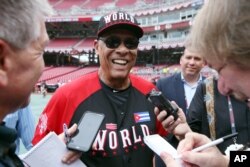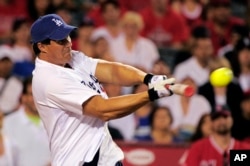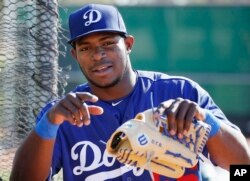The path to playing Major League Baseball has historically not been clear or easy for Cubans.
That is particularly true for black Cuban players, who in the early 1900s were confined to the Negro Leagues in the United States while whites played on MLB teams.
Integration led to Minnie Minoso being the first black Cuban MLB player in 1949, but a decade later Fidel Castro seized power in Cuba and the subsequent breakdown in relations with the United States meant the league was no longer an option for players still inside Cuba unless they defected.
Castro’s politics and his decision to shut down professional teams in Cuba sent some of the great baseball players from two generations fleeing to the U.S.
First wave of players
The first wave included Hall of Fame first baseman Tony Perez, a seven-time All-Star who won two World Series with the Cincinnati Reds, as well as three-time all-star pitcher Luis Tiant and three-time World Series champion Oakland Athletics shortstop Bert Campaneris.
Minoso was already in the United States, but Castro’s policies influenced his decision to leave for good.
Those players were all adults in the early 1960s, but at the same time two children who would grow up to be two of the best hitters to ever come out of Cuba were taken to the U.S. by their parents.
Rafael Palmeiro played 20 seasons in the majors, mostly with the Texas Rangers and Baltimore Orioles, combining a slick glove at first base with a powerful bat that amassed 569 home runs and 3,020 hits.
He was 6 years old when his parents took advantage of the so-called Freedom Flights that brought a quarter-million Cubans to the U.S. between 1965 and 1973.
Jose Canseco
A plane also brought an infant named Jose Canseco, whose family settled in the Miami area. He went on to star for Oakland and several other teams, slugging more than 40 home runs in a season three times and winning two World Series.
Palmeiro, and to a lesser extent Canseco, arguably should be considered to join Perez and three other Cubans from the Negro Leagues whose resumes earned them spots in the National Baseball Hall of Fame.
But both admitted to using steroids during their careers, which blackballed them in the eyes of voters.
A new wave of Cuban players, those who defected in sometimes dangerous circumstances under Castro’s government, is highlighted by pitcher Livan Hernandez.
He fled in 1995 while the Cuban national team was playing in Mexico and established himself as a workhorse starter in the majors who helped the then-Florida Marlins win a World Series during his 17-year career.
His brother, Orlando, fled Cuba on a boat two years later. His career was shorter, but flashier, as the high-kicking pitcher nicknamed “El Duque” won three World Series with dominant New York Yankees teams and another with the Chicago White Sox.
Retirements, new players
The Hernandez brothers and others like shortshop Rey Ordonez and catcher Eli Marrero retired just as the current crop of Cuban defectors began breaking into the league.
This season, 27 Cubans have a chance to make MLB rosters and most will, starring for some of the league’s most prominent franchises.
In Miami, phenom Jose Fernandez, who throws a knee-buckling curveball, leads the Marlins pitching staff. He was caught three times trying to flee on a boat as a teenager, and his successful fourth attempt involved first getting ashore in Mexico before crossing the U.S. border into Texas.
For outfielder Yasiel Puig, the journey to playing for the Los Angeles Dodgers also involved multiple attempts and eventually being taken on a boat by smugglers and later held in Mexico while they demanded hundreds of thousands of dollars in payment.
Pitcher Aroldis Chapman and his 160 kph fastball will be closing games for the Yankees. He defected in less dangerous circumstances, walking away from the Cuban national team while they were in the Netherlands.
Across town, Yeonis Cespedes is being counted on to mash home runs and use his elite outfield arm to help the New York Mets return to the World Series. He fled Cuba on a boat to the Dominican Republic in 2011.
The defections continue today, with the latest high-profile case coming last month as brothers Lourdes and Yulieski Gurriel fled the national team after they lost in the Caribbean Series in the Dominican Republic.










